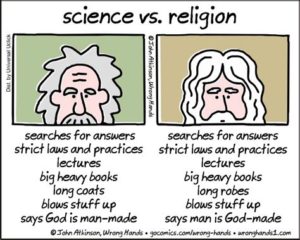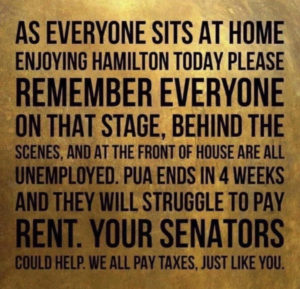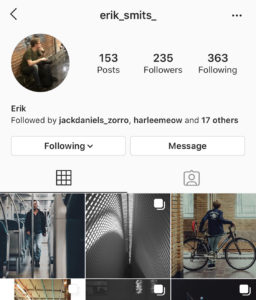
COVID Contradictions
I just watched Hamilton via streaming, and I am blown away. Not just by the musical, which I did see live awhile back (a touring company in Schenectady, NY) and which is exceptional, but by the access potential that has been revealed by COVID sequestering.
2020 is a year of total contradictions. Besides us constantly contradicting each other by throwing falsehoods against truths as if they were equally valid, besides science versus faith as if they are incompatible, (hah) and besides the revelation that art and actors are losing all their safety nets just when we need them the most, I marvel at the expanded access while we are so physically restricted.
These contradictions are not game stoppers, but game-changers, if we explore and choose to do things differently.
Hold up. I can’t turn my back on those awful contradictions. This blog was intended to be about the good, but I would be wrong to celebrate the good without talking about the bad and maybe offering a couple of thoughts, maybe even actions, that can be explored and taken.
 Contradicting each other, especially about politicized things. We have stopped listening, and we need to re-engage with our ears and brains. Communication is two-way. We must speak and think about who is listening and if the words, the expressions, the stories we are using are reaching them in a way they can comprehend. This is not to say we need to “cater to” our listener or allow their biases to contaminate what we are trying to share, but we certainly have to consider them and use that knowledge to reach the beauty of successful communication. Which means we also have to listen to their words, their emotions, their body language. We need to be honest and open and CURIOUS, instead of defensive. And we need to get beyond the labels. As soon as you tell someone they are biased or “left” or “conservative” or “not listening” you have given them an out, an excuse to not listen. Don’t draw those lines or build those walls – they do not help with conversation, communication, or community-building.
Contradicting each other, especially about politicized things. We have stopped listening, and we need to re-engage with our ears and brains. Communication is two-way. We must speak and think about who is listening and if the words, the expressions, the stories we are using are reaching them in a way they can comprehend. This is not to say we need to “cater to” our listener or allow their biases to contaminate what we are trying to share, but we certainly have to consider them and use that knowledge to reach the beauty of successful communication. Which means we also have to listen to their words, their emotions, their body language. We need to be honest and open and CURIOUS, instead of defensive. And we need to get beyond the labels. As soon as you tell someone they are biased or “left” or “conservative” or “not listening” you have given them an out, an excuse to not listen. Don’t draw those lines or build those walls – they do not help with conversation, communication, or community-building.
 Science versus faith is another piece that drives me nuts. And maybe this is also an issue of words. “Faith” has often gotten bogged down in labels tied to different religions, as in the image above, and I feel that faith transcends schools of particular thought or worship practice. On top of this, science, to me, is the study of the things that spark our faith, and the science we employ and its revelations are not intended in any way to diminish faith, but to help faith move further and deeper. Each scientific explanation gives us room to wonder about something else magnificent. To explore mysteries, to celebrate spirituality, to honor a creator (whatever s/he/it be named in your religion), and to rediscover our connections to each other, Nature, and the planet we live upon and with. To learn how to nurture and shepherd as we are called upon to do in so many religions. That we exist at all is rife with faith. That we are curious enough to want to understand existence through scientific explorations and proofs is also part of our faith and our being.
Science versus faith is another piece that drives me nuts. And maybe this is also an issue of words. “Faith” has often gotten bogged down in labels tied to different religions, as in the image above, and I feel that faith transcends schools of particular thought or worship practice. On top of this, science, to me, is the study of the things that spark our faith, and the science we employ and its revelations are not intended in any way to diminish faith, but to help faith move further and deeper. Each scientific explanation gives us room to wonder about something else magnificent. To explore mysteries, to celebrate spirituality, to honor a creator (whatever s/he/it be named in your religion), and to rediscover our connections to each other, Nature, and the planet we live upon and with. To learn how to nurture and shepherd as we are called upon to do in so many religions. That we exist at all is rife with faith. That we are curious enough to want to understand existence through scientific explorations and proofs is also part of our faith and our being.
 Art is the first to be defunded, and the most needed for our emotional, spiritual, and mental resilience. This one I cannot readily address without getting political. We need to think long-term about the value of art. There is a failure in the arts being one of the industries (strange word, but I can’t think of another) that is quickest to be shelved in times of financial struggle, while we know that it is the most imperative endeavor for sustenance of the human spirit, and creation of respect across cultures. Especially with the streaming of Hamilton, there have been repeated reminders that the actors, stagehands, costumers, lighting team and on and on are all without work at this time, and that their unemployment benefits are gone soon. Pandemic Unemployment Assistance (PUA) ends on August 1. So many people in the arts are self-employed, because employment tied to a corporation ends up commoditizing art no matter how good the intent or how aware the CEO is. Even architecture, which is a corporatized and regulated art, ebbs when investment dollars are not available and long-term thinking becomes next to impossible for most. And yet this is the time for long-term thinking and planning. So what can we do about this?
Art is the first to be defunded, and the most needed for our emotional, spiritual, and mental resilience. This one I cannot readily address without getting political. We need to think long-term about the value of art. There is a failure in the arts being one of the industries (strange word, but I can’t think of another) that is quickest to be shelved in times of financial struggle, while we know that it is the most imperative endeavor for sustenance of the human spirit, and creation of respect across cultures. Especially with the streaming of Hamilton, there have been repeated reminders that the actors, stagehands, costumers, lighting team and on and on are all without work at this time, and that their unemployment benefits are gone soon. Pandemic Unemployment Assistance (PUA) ends on August 1. So many people in the arts are self-employed, because employment tied to a corporation ends up commoditizing art no matter how good the intent or how aware the CEO is. Even architecture, which is a corporatized and regulated art, ebbs when investment dollars are not available and long-term thinking becomes next to impossible for most. And yet this is the time for long-term thinking and planning. So what can we do about this?
I need to shift gears a bit, to see if my joyous observations reveal any possible approaches.
I am in my home and on my porch (so grateful for a porch and safe backyard, and walkable community) yet I am connecting with more people from my life in more ways than I ever imagined. Yes, this is part of my privilege, that I have the tech resources and the financial means to do so. I acknowledge that, and we need to make that access less a privilege and infinitely more available. I can Zoom. I can work from home and be fully supported in that by the state authority for which I work. I am not in a service role that must wait on tables, work to heal and support the sick, clean places fouled by others, police a community, or deliver the vast amounts of STUFF we order every day. I do not have financial stresses other that what I had planned for with a son heading to college. I am sincerely grateful.
 BTW, my son intends to be a professional photographer, and he is already so very good (check out his Instagram feed at erik_smits_), which is one of the arts we tend to under-appreciate, even while we are made whole by art and what it reveals to us.
BTW, my son intends to be a professional photographer, and he is already so very good (check out his Instagram feed at erik_smits_), which is one of the arts we tend to under-appreciate, even while we are made whole by art and what it reveals to us.
I not only have zoomed a couple of times with people from all over the world, a benefit of travels with Up With People over 25 years ago, but I recently re-connected with some theatre friends from college, and hope to do some theatrical explorations this week, remotely. No clue how it will go, but it’s worth a shot!
I am connecting to knowledge, tapping into podcasts, which I have never done. Learning sketchup, which I have long wanted to do. Reading some non-fiction, which I don’t enjoy enough in the moment, but which is incredibly beneficial to my thought processes and ability to assess potential in my work, and my play.
My neighborhood is actually turning into one. As I walked to the local bar to fill my growler last night, a neighbor was tending her front yard and asked me if I wanted to hang on her front porch with my beer for a bit. So she and her fiancé and I all visited, outside, at good distance from each other in open air, ordered food, kept talking, and about 5 hours later I walked halfway down the block to my home. This is amazingly connective stuff.
So I am less connected and more, simultaneously. My favorite contradiction of 2020.
I think this helps me to figure out some solutions for the arts contradiction. Some that I can connect you to, and make happen myself:
- Connect. I see my actor friend in NYC teaching on-line, and maybe my couple of college friends and I can have him coach us going forward. That would be support of him and of the arts.
- Support. When we celebrate art, think about how to support that artist, with a donation if possible, certainly promotion and connections, and with our expressed appreciation. Too often we love something we see, but never tell the creator. This must change.
- I can reach out for podcasts, and support them via patreon.com and other support mechanisms as available.
- I can promote Instagram feeds more. Not the blatant ads, unless it’s a sustainable company or a local one, but the explorers and artists out there.
- Increase access. Make more live theatre movies for streaming. Arts on stage will always be attended, and in fact maybe we can bring back some of the specialness of it, so the events are themselves celebrations.
- At the same time by providing widespread access, through streaming, and through neighborhood watch events (i’m thinking outdoor movie night at local parks!) we create more theatre lovers AND more access to thoughts and situations beyond our own limited experiences.
- Do more art. Put your own hands and mind to work. I really think appreciation for art comes not only in being a spectator, but in being a practitioner. It helps you see and understand the effort taken, the expertise developed, and the messages in the process.
- I can change up my own work – time to explore an audio version of my own writing, or an interview format video series that celebrates the sustainability work going on. This is not an art, really, but can help maintain connections we need for the long-term transition to our sustainable and resilient future. And art will be part of that future, for certain.
- Step 1, above all, is recognizing the value of the arts, and we can all help with this. We can each normalize art in any and all formats by sharing what appeals to us, what informs us, what challenges us, and by expressing our gratitude for its creation.
So these contradictions are not game stoppers, but game-changers, if we explore and choose to do things differently. What opportunities do you have to celebrate art in your daily connections? How has COVID changed how you do this? Has it made it harder for you to connect with arts? What can artists (actors, singers, writers, painters, photographers, crafters….the list goes on) do to help YOU stay connected to these vital explorations and expressions? Remember, communication is two-way. We need to tell people working in the arts HOW we can support them so they can support us.
Long live our creativity, even in this time of COVID Contradictions.
Be greener,
Jodi
Be the first to like this post (no login required)